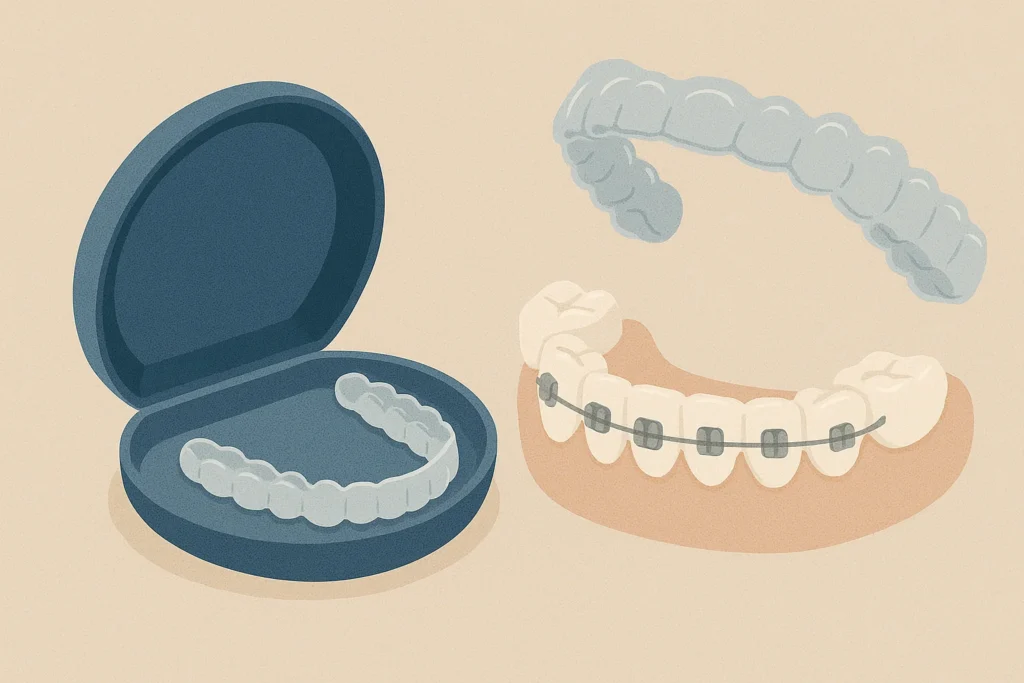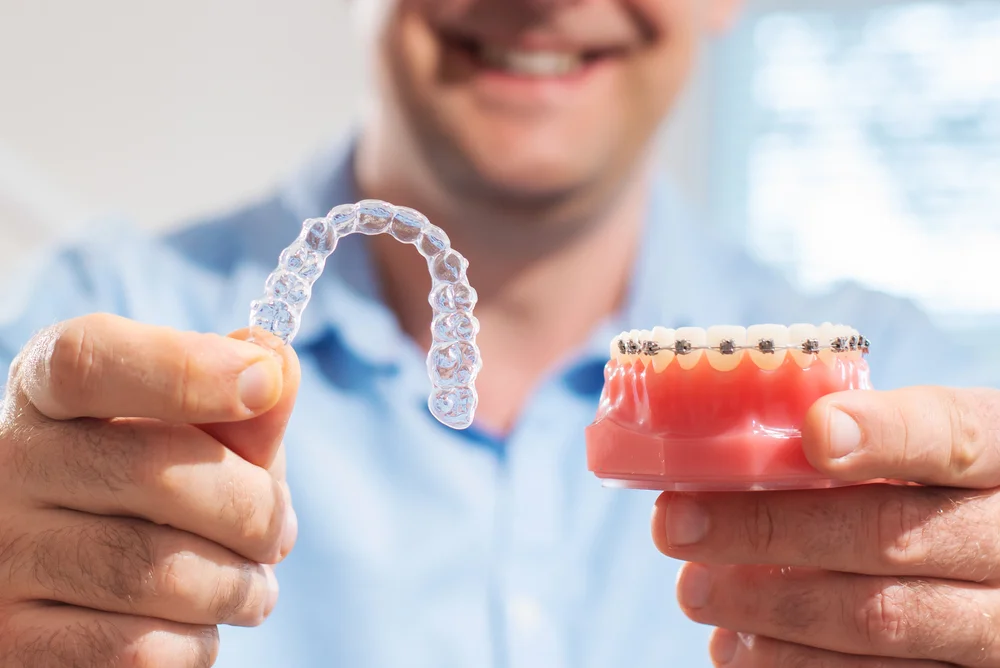Invisalign vs Traditional Orthodontics in San Antonio Texas and Leon Valley, which one is better for you. When deciding how to achieve a straighter, healthier smile, many patients find themselves weighing Invisalign against traditional braces. Both systems are effective, but they operate differently and serve distinct patient needs. Choosing the right approach involves evaluating not only the nature of the orthodontic issue but also the patient’s lifestyle, aesthetic goals, budget, and treatment expectations.
Orthodontic care is not one-size-fits-all. At Village Periodontics & Implant Dentistry, we help patients select the best method by considering clinical factors and personal preferences. Invisalign offers sleek, nearly invisible aligners, while traditional braces continue to deliver powerful, precise results for complex dental corrections. The decision isn’t simply cosmetic—it’s strategic. This article breaks down each approach so patients can make the most informed choice.
Evaluating Effectiveness in Orthodontic Treatment
Effectiveness is one of the most important factors when comparing Invisalign and traditional braces. Both methods are designed to straighten teeth, but their respective strengths make each better suited for specific orthodontic challenges. Traditional braces use metal or ceramic brackets connected by wires to apply continuous pressure, making them highly effective for treating severe bite issues, significant rotations, or complex spacing problems.
In contrast, Invisalign is ideal for mild to moderate alignment issues. The custom-made aligners gradually reposition teeth using gentle pressure over time. Because they are designed digitally and tailored to the patient’s anatomy, they can deliver impressive results in less severe cases. However, Invisalign may not provide the same level of control in treating major dental irregularities. This makes braces the preferred option for patients with extensive misalignment or skeletal malocclusion that requires comprehensive mechanical force.
Understanding Which Treatment Aligns with Your Lifestyle
Lifestyle and daily habits also play a major role in determining the right orthodontic path. Invisalign is favored by adults and teens who prioritize discretion. The aligners are virtually invisible and can be removed for meals, brushing, and flossing, making them particularly convenient for people with active social or professional lives. A patient preparing for a wedding or giving frequent presentations might prefer Invisalign to preserve a clean, camera-ready smile.
Traditional braces, while more visible, are often the best fit for patients who want a set-it-and-forget-it treatment. Once applied, braces remain in place 24/7, requiring less patient discipline. This makes them a smart option for younger patients or individuals who might forget to wear aligners consistently. With fewer variables to manage day-to-day, traditional braces may offer peace of mind to those seeking predictable results with minimal personal responsibility.
Comparing Comfort and Wearability
Comfort is a subjective but critical consideration. Invisalign aligners are made from smooth plastic, which means fewer abrasions inside the mouth. Their removable nature allows for unrestricted eating and easy maintenance of oral hygiene routines. For patients involved in sports or physical activities, the flexibility and reduced risk of injury from sharp brackets make Invisalign a more appealing and safer option.
However, braces have evolved in recent years and now come in options like ceramic braces or smaller bracket systems that improve comfort and reduce visibility. Despite these advancements, braces may still cause irritation due to metal parts and require dietary restrictions to avoid damaging the appliance. Certain foods like popcorn, gum, or hard candy are off-limits. Patients must also use specialized tools to brush and floss effectively, making oral care more time-consuming.
Weighing Treatment Time and Financial Investment
Treatment time is another factor where the differences between Invisalign and braces are apparent. Invisalign tends to have a shorter average treatment duration—typically between 12 to 18 months. For adults seeking fast results with minimal disruption, this faster timeline is often a major selling point. The ability to remove aligners can also help maintain better gum and tooth health, potentially avoiding complications that could prolong treatment.
Traditional braces usually require 18 to 24 months or more, especially for complex cases. However, this extended timeframe reflects the thorough and transformative corrections braces can achieve. In terms of cost, Invisalign and braces are relatively comparable, though insurance coverage, treatment duration, and complexity can influence final pricing. In cases requiring extensive alignment, braces may offer better long-term value, especially if fewer refinements or revisions are needed compared to a longer Invisalign case.

Addressing Specific Orthodontic Needs
Each patient presents unique dental conditions that influence the optimal treatment method. Braces shine when addressing severe overbites, crossbites, large gaps, or extreme crowding. Their fixed nature allows orthodontists to apply continuous pressure and make detailed adjustments throughout treatment. For example, patients with rotated molars or impacted teeth benefit from the mechanical strength and control that braces offer.
Invisalign, while not as forceful, excels at treating common misalignments such as minor crowding, small gaps, or midline shifts. It is also highly effective for relapse cases—where previous orthodontic work has shifted over time and needs realignment. Patients who want to improve their smile with minimal interference in their lifestyle often choose Invisalign, especially when the corrections are more cosmetic than structural.
Hygiene, Maintenance, and Oral Health Considerations
Oral hygiene routines differ significantly between the two systems. Invisalign simplifies brushing and flossing because the aligners are removable. Patients can maintain their normal routine without needing additional tools. However, Invisalign wearers must be vigilant about brushing after every meal to prevent staining the aligners or trapping food particles that could lead to decay.
Braces demand a higher level of attention to hygiene. Food and plaque can accumulate around brackets and wires, increasing the risk of cavities and gum disease if not properly cleaned. Patients must use orthodontic flossers or water picks to clean thoroughly between wires and brackets. This process requires time and consistency but is necessary to protect the underlying teeth throughout the longer treatment period.
Factoring in Discipline and Compliance
Patient compliance is essential for Invisalign success. Aligners must be worn for 20 to 22 hours a day and only removed for eating and oral care. If a patient fails to wear them consistently, progress may stall or reverse, extending the treatment timeline. This requirement makes Invisalign best suited for disciplined individuals who can stick to a structured regimen.
Traditional braces eliminate the risk of non-compliance because they cannot be removed. This built-in accountability is particularly helpful for children and teens who might lose or neglect aligners. In this context, braces serve as a more reliable method, ensuring uninterrupted treatment progress regardless of patient discipline or routine interruptions.
Matching Aesthetic Priorities to the Right Solution
For many patients, appearance during treatment is a top concern. Invisalign’s transparent trays offer an almost invisible solution, making them highly desirable for image-conscious individuals. From corporate professionals to students to public figures, Invisalign provides a way to align teeth without broadcasting the process.
Braces, although more noticeable, now come in lower-profile designs and clear or tooth-colored options. For patients who want effective treatment but don’t mind a visible appliance, modern braces strike a balance between form and function. While they may be more obvious, their strong corrective capabilities often outweigh cosmetic concerns, especially for patients focused on long-term transformation.
Collaborating with Experts to Make the Best Choice
The most effective way to decide between Invisalign and traditional braces is through a comprehensive consultation with an orthodontic professional. Orthodontists assess the full scope of your dental condition using imaging tools and bite analysis, then present a treatment plan tailored to your goals and oral health needs.
At Village Periodontics & Implant Dentistry, we guide patients through this decision-making process by educating them on the pros and cons of each option and helping them weigh lifestyle, comfort, budget, and long-term outcomes. Our goal is not to steer you toward one method or the other, but to ensure you have the knowledge to make a confident, informed choice that delivers lasting results.
Conclusion: Choosing What’s Right for Your Smile
Whether you choose Invisalign or traditional braces, your path to a healthier, straighter smile should align with your lifestyle, priorities, and oral health needs. Invisalign offers a sleek, low-profile solution for mild to moderate corrections with the flexibility many adults and teens appreciate. Traditional braces provide robust, reliable correction for complex issues and remain the gold standard for challenging orthodontic work.
Ultimately, the best orthodontic treatment is the one that fits your life and delivers the results you want. With the guidance of a skilled dental team and a customized plan, you can achieve the smile you’ve always wanted, on your terms.
With Fountain of Youth Dental, you can stop settling and finally get the healthy, stunning smile you deserve!
Schedule Your Free Consultation Today!
Fountain of Youth Dental
5282 Medical Dr. #520 San Antonio, TX 78229 (210) 614-5481 Driving Directions VISIT OUR WEBSITE
FAQs: Invisalign vs Traditional Braces
Is Invisalign better than braces?
Not necessarily—it depends on your case. Invisalign is great for mild to moderate issues and is more discreet, while braces are often better for complex or structural dental corrections.
How long does Invisalign take compared to braces?
Invisalign usually takes 12 to 18 months, while braces can take 18 to 24 months or more, especially for complicated cases. The exact time depends on your dental needs and compliance.
Which option is more comfortable?
Invisalign is typically more comfortable due to its smooth plastic design and lack of metal. Braces can cause irritation, especially early in treatment, but are more effective for certain complex issues.
Related Articles
Invisalign Explained, Invisalign Costs Explained, The Invisalign Process, Invisalign vs Traditional Braces, Invisalign Maintenance Tips, Benefits of Invisalign, How Long Does Invisalign Take?, What is Malocclusion, Invisalign Clear Aligners, Braces





